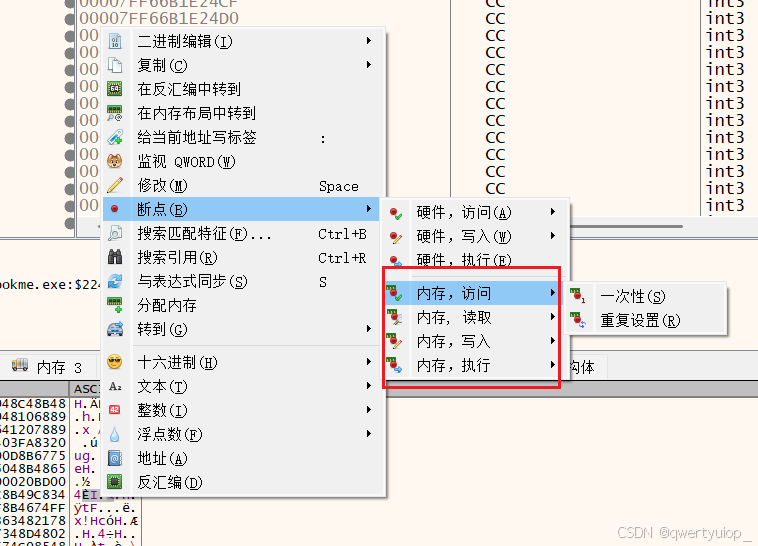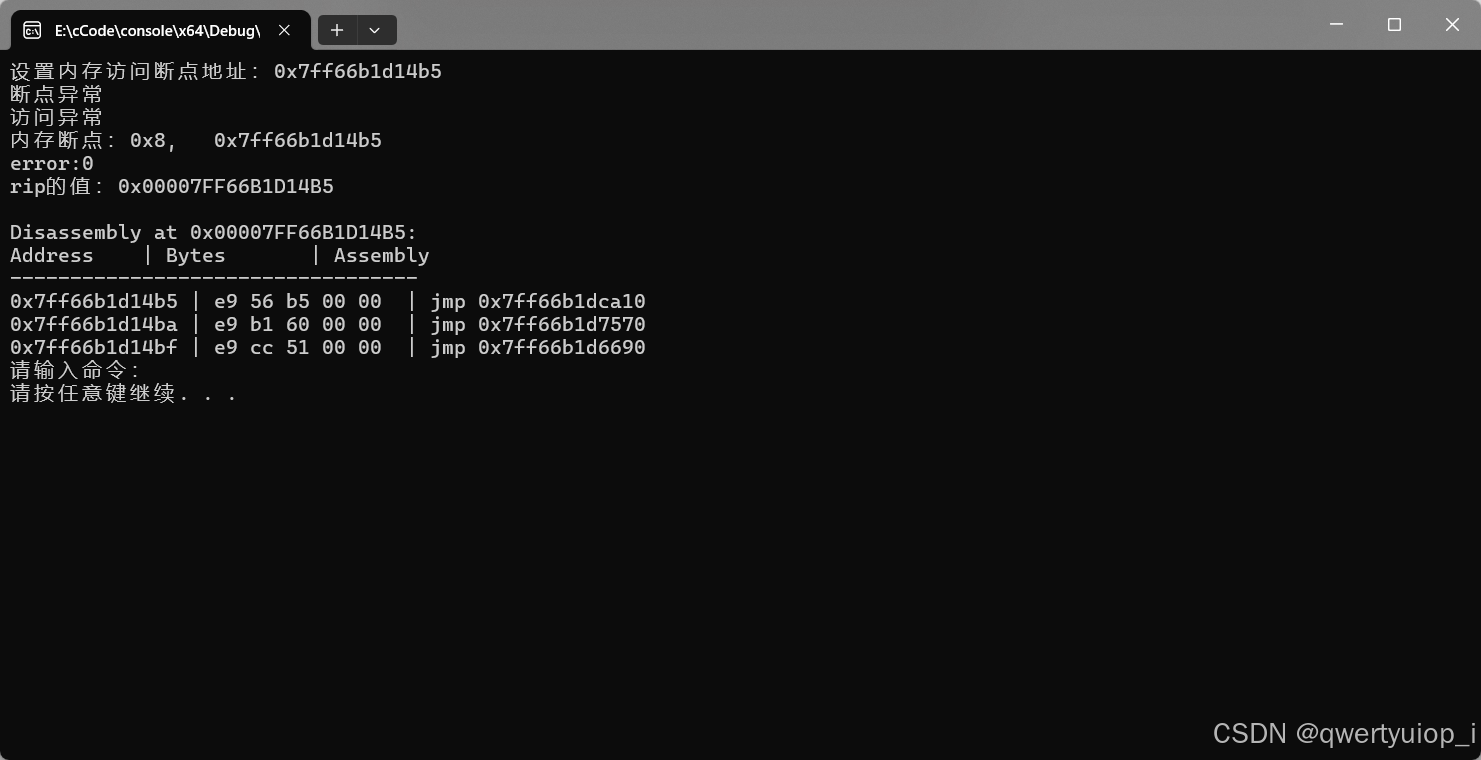软件调试
内存断点
无论是软件断点,内存断点,还是硬件断点,其本质就是让指定位置发生异常
在x64dbg中可以选择一块内存对当前的内存的访问、读取、写入、执行操作下不同的断点

通过VirtualProtectEx函数就可以进行设置,本质上就是设置页的属性
cpp
BOOL VirtualProtectEx(
[in] HANDLE hProcess,
[in] LPVOID lpAddress,
[in] SIZE_T dwSize,
[in] DWORD flNewProtect,
[out] PDWORD lpflOldProtect
);当flNewProtect的属性被PAGE_NOACCESS,当前内存一但访问就会发生异常,这就是内存访问断点,这里观察PTE,此时P位为0,同理当要设置内存写入断点时,只需要把flNewProtect属性改PAGE_READONLY,(PTE P = 1 R/W = 0)设置为只读,一但有人写入这里,就会触发异常
代码测试
cpp
#include<iostream>
#include<windows.h>
#include <stdint.h>
#include <capstone/capstone.h>
#define DEBUGGR_PROCESS L"C:\\Users\\BananaLi\\Desktop\\HookMe.exe"
// 保存原始字节
BYTE originalByte;
BYTE int3 = 0xCC; // INT3 断点指令
HANDLE g_hDebugThread;
HANDLE g_hDebugProcess;
BOOL bInitCapstone = TRUE;
CONTEXT context = { 0 };
BOOL bIsSystemInt3 = TRUE; // 第一次为系统断点 ntdll!LdrInitializeThunk
DWORD dwContinue DBG_CONTINUE;
LPVOID lpAddress;
//HANDLE hProcess;
DWORD pDwOriginalProtect; // 原保护标志指针
void DisassembleHex(HANDLE g_hDebugProcess, LPVOID address, size_t size);
BOOL WaitForUserCommand();
// 定义 Capstone 函数指针类型
typedef unsigned int (*cs_open_fn)(unsigned int arch, unsigned int mode, void** handle);
typedef unsigned int (*cs_disasm_fn)(void* handle, const uint8_t* code, size_t code_size, uint64_t address, size_t count, cs_insn** insn);
typedef void (*cs_free_fn)(cs_insn* insn, size_t count);
typedef unsigned int (*cs_close_fn)(void** handle);
// 设置内存访问断点
void setMemoryBreakPoint(DEBUG_EVENT* pDebugEvent) {
lpAddress = pDebugEvent->u.CreateProcessInfo.lpStartAddress;
// 访问断点 PTE 的P位=0,表示禁止访问,任何对当前地址的访问都会导致异常,只要触发异常,就会被我们调用器捕获
printf("设置内存访问断点地址:0x%llx\n",lpAddress);
MEMORY_BASIC_INFORMATION mbi;
if (VirtualQueryEx(g_hDebugProcess, lpAddress, &mbi, sizeof(mbi))) {
// 确保区域状态为MEM_COMMIT
VirtualProtectEx(g_hDebugProcess, lpAddress, 8, PAGE_NOACCESS, &pDwOriginalProtect);
}
}
// 访问冲突异常处理函数
BOOL AccessViolationExcptionProc(EXCEPTION_DEBUG_INFO* pExceptionInfo) {
// 需要考虑的事情
// 1.我们可以对任意大小内存设置内存断点
// 2.假如我设置的一块内存断点,它们不在一个分页上,该怎么处理?
BOOL bRet = FALSE;
DWORD dwAccessFlag; // 访问类型 0读 1写 8执行
DWORD64 dwAccessAddr; // 引发异常的 内存地址
DWORD dwProtect = NULL;
// 获取异常信息,修改内存属性
dwAccessFlag = pExceptionInfo->ExceptionRecord.ExceptionInformation[0]; // 访问类型
dwAccessAddr = pExceptionInfo->ExceptionRecord.ExceptionInformation[1]; // 异常地址
printf("内存断点:0x%llx,\t 0x%llx\n", dwAccessFlag, dwAccessAddr);
if (dwAccessAddr == (DWORD64)lpAddress) {
VirtualProtectEx(g_hDebugProcess, (LPVOID)dwAccessAddr, 8, pDwOriginalProtect, &dwProtect); // 还原属性
}
// 获取线程上下文
context.ContextFlags = CONTEXT_FULL | CONTEXT_DEBUG_REGISTERS;
BOOL aa = GetThreadContext(g_hDebugThread, &context);
printf("error:%d\n", GetLastError());
printf("rip的值:0x%p\n\n", context.Rip);
// 内存访问异常不需要修正rip
SetThreadContext(g_hDebugThread, &context);
// 反汇编代码 和 显示寄存器信息。。。
DisassembleHex(g_hDebugProcess, lpAddress,16);
// 等待用户输入命令
while (bRet == FALSE) {
bRet = WaitForUserCommand();
}
return bRet;
}
void DisassembleHex(HANDLE g_hDebugProcess, LPVOID address, size_t size) {
// 1. 加载 capstone.dll
HMODULE capstone_dll = LoadLibrary(L"C:\\Users\\BananaLi\\Desktop\\capstone_x64.dll");
if (!capstone_dll) {
printf("Failed to load capstone.dll! Error: %d\n", GetLastError());
}
// 2. 获取函数指针
cs_open_fn cs_open = (cs_open_fn)GetProcAddress(capstone_dll, "cs_open");
cs_disasm_fn cs_disasm = (cs_disasm_fn)GetProcAddress(capstone_dll, "cs_disasm");
cs_free_fn cs_free = (cs_free_fn)GetProcAddress(capstone_dll, "cs_free");
cs_close_fn cs_close = (cs_close_fn)GetProcAddress(capstone_dll, "cs_close");
if (!cs_open || !cs_disasm || !cs_free || !cs_close) {
printf("Failed to get Capstone functions!\n");
FreeLibrary(capstone_dll);
}
// 3. 初始化 Capstone(x64 模式)
void* handle;
if (cs_open(CS_ARCH_X86, CS_MODE_64, &handle) != CS_ERR_OK) {
printf("Failed to initialize Capstone!\n");
FreeLibrary(capstone_dll);
}
// 2. 从内存读取指令字节
uint8_t code[32];
SIZE_T bytesRead;
if (!ReadProcessMemory(g_hDebugProcess, address, code, size, &bytesRead) || bytesRead != size) {
printf("Failed to read memory at 0x%p\n", address);
cs_close(&handle);
return;
}
// 3. 反汇编
cs_insn* insn;
size_t count = cs_disasm(handle, code, bytesRead, (uint64_t)address, 0, &insn);
if (count > 0) {
printf("Disassembly at 0x%p:\n", address);
printf("Address | Bytes | Assembly\n");
printf("----------------------------------\n");
for (size_t i = 0; i < count; i++) {
printf("0x%08llx | ", insn[i].address);
for (size_t j = 0; j < insn[i].size; j++) {
printf("%02x ", insn[i].bytes[j]);
}
printf("%*s | %s %s\n",
(int)(15 - insn[i].size * 3), "",
insn[i].mnemonic,
insn[i].op_str);
}
cs_free(insn, count);
}
else {
printf("Failed to disassemble at 0x%p\n", address);
}
// 4. 关闭引擎
cs_close(&handle);
}
BOOL WaitForUserCommand() {
// 模拟调试器等待用户输入命令
printf("请输入命令:\n");
system("pause");
return TRUE;
}
BOOL Int3ExcptionProc(EXCEPTION_DEBUG_INFO* pExceptionInfo) {
BOOL bRet = FALSE;
// 第一次为系统断点
if (bIsSystemInt3) {
bIsSystemInt3 = FALSE;
return TRUE;
}
else {
// 恢复原码
BOOL nnn = WriteProcessMemory(g_hDebugProcess, pExceptionInfo->ExceptionRecord.ExceptionAddress, &originalByte, 1, NULL);
printf("error : %d\n", GetLastError());
// 显示断点位置
printf("Int 3断点地址:0x%p\n",pExceptionInfo->ExceptionRecord.ExceptionAddress);
// 获取线程上下文
context.ContextFlags = CONTEXT_FULL | CONTEXT_DEBUG_REGISTERS;
GetThreadContext(g_hDebugThread, &context);
// 修正rip
context.Rip--;
printf("rip的值:0x%p\n\n", context.Rip);
SetThreadContext(g_hDebugThread, &context);
FlushInstructionCache(GetCurrentProcess(),(LPCVOID)context.Rip,1);
printf("------------还原后的正确汇编指令------------\n");
// 从断点位置解释反汇编代码
DisassembleHex(g_hDebugProcess, lpAddress,16);
// 等待用户输入命令
while (bRet == FALSE) {
bRet = WaitForUserCommand();
}
}
return bRet;
}
void setInt3BreakPoint(DEBUG_EVENT* pDebugEvent) {
// 获取进程入口点地址
LPTHREAD_START_ROUTINE lpStartAddress = (LPTHREAD_START_ROUTINE)
pDebugEvent->u.CreateProcessInfo.lpStartAddress;
/*hProcess = pDebugEvent->u.CreateProcessInfo.hProcess; */
lpAddress = pDebugEvent->u.CreateProcessInfo.lpStartAddress;
printf("断点位置:0x%p\n",lpAddress);
DWORD64 oldAddressData;
ReadProcessMemory(g_hDebugProcess, lpAddress, &oldAddressData, sizeof(DWORD64), NULL);
printf("保存前断点地址对应的硬编码:%llx\n" , oldAddressData);
// 1. 保存原始字节
ReadProcessMemory(g_hDebugProcess, lpAddress, &originalByte, sizeof(BYTE), NULL);
printf("保存的originalByte:%llx\n", originalByte);
// 2. 写入INT3指令
WriteProcessMemory(g_hDebugProcess, lpAddress, &int3, sizeof(BYTE), NULL);
ReadProcessMemory(g_hDebugProcess, lpAddress, &oldAddressData, sizeof(DWORD64), NULL);
printf("保存后断点地址对应的硬编码:%llx\n\n", oldAddressData);
printf("------------设置软件断点后的汇编指令------------\n");
// 从断点位置解释反汇编代码
DisassembleHex(g_hDebugProcess, lpAddress, 16);
// 3. 刷新指令缓存
FlushInstructionCache(g_hDebugProcess, lpAddress, sizeof(BYTE));
}
// 异常过滤器
BOOL ExceptionHandler(DEBUG_EVENT* pDebugEvent) {
BOOL bRet = TRUE;
// 得到异常信息
EXCEPTION_DEBUG_INFO exceptionInfo = pDebugEvent->u.Exception;
// 得到线程句柄
// 判断 异常类型
switch (exceptionInfo.ExceptionRecord.ExceptionCode) {
// int 3 异常
case EXCEPTION_BREAKPOINT: {
printf("断点异常\n");
bRet = Int3ExcptionProc(&exceptionInfo);
break;
}
// 0xC0000005 访问冲突异常
case EXCEPTION_ACCESS_VIOLATION: {
printf("访问异常\n");
bRet = AccessViolationExcptionProc(&exceptionInfo);
break;
}
// 还有很多其他的异常类型可以处理。。。
}
return bRet;
}
int main() {
BOOL nIsContinue = TRUE;
DEBUG_EVENT debugEvent = { 0 };
BOOL bRet = TRUE;
// 1.创建调试进程
STARTUPINFO startUpInfo = { 0 };
PROCESS_INFORMATION pInfo = { 0 };
GetStartupInfo(&startUpInfo);
bRet = CreateProcess(DEBUGGR_PROCESS, NULL, NULL, NULL, TRUE, DEBUG_PROCESS || DEBUG_ONLY_THIS_PROCESS, NULL, NULL, &startUpInfo, &pInfo);
if (bRet == FALSE) {
printf("创建调试进程失败,错误码:%d\n",GetLastError());
return 0;
}
// 调试循环(主框架)
while (nIsContinue) {
// 2.等待调试事件
bRet = WaitForDebugEvent(&debugEvent, INFINITE);
if (bRet == FALSE) {
printf("等待调试事件失败,错误码:%d\n", GetLastError());
return 0;
}
// 得到线程句柄
g_hDebugThread = OpenThread(THREAD_ALL_ACCESS, FALSE, debugEvent.dwThreadId);
// 得到进程句柄
g_hDebugProcess = OpenProcess(PROCESS_ALL_ACCESS, FALSE, debugEvent.dwProcessId);
switch (debugEvent.dwDebugEventCode) {
case EXCEPTION_DEBUG_EVENT: {
// 处理异常
bRet = ExceptionHandler(&debugEvent);
if (!bRet)
dwContinue = DBG_EXCEPTION_NOT_HANDLED;
break;
}
case CREATE_PROCESS_DEBUG_EVENT: {
// 在OPE入口设置断点
//setInt3BreakPoint(&debugEvent);
// 在OPE入口设置内存访问断点
setMemoryBreakPoint(&debugEvent);
break;
}
case EXIT_PROCESS_DEBUG_EVENT: {
nIsContinue = FALSE;
break;
}
case CREATE_THREAD_DEBUG_EVENT: {
break;
}
case EXIT_THREAD_DEBUG_EVENT: {
break;
}
case LOAD_DLL_DEBUG_EVENT: {
break;
}
case UNLOAD_DLL_DEBUG_EVENT: {
break;
}
default:
break;
}
// 让被调试程序继续运行
bRet = ContinueDebugEvent(debugEvent.dwProcessId, debugEvent.dwThreadId, dwContinue);
}
return 0;
}效果展示
